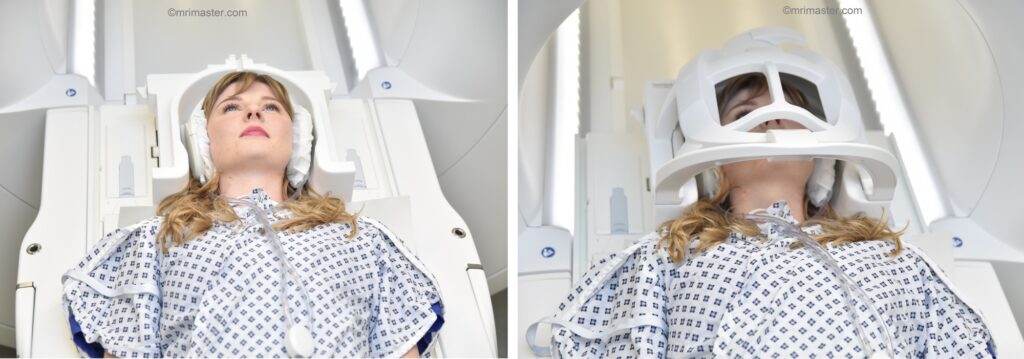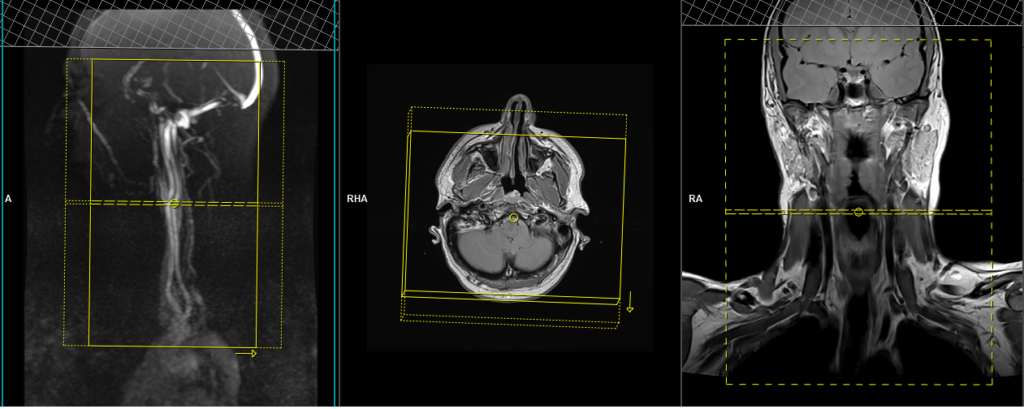Magnetic resonance angiography (MRA) Neck
Indications for Magnetic Resonance Angiography of neck
- Cervicocranial arterial dissection
- Arterio-venous malformation
- Vertebrobasilar syndrome
- Injury to the carotid artery
- Aneurysm
- Tumours
Contraindications
- Any electrically, magnetically or mechanically activated implant (e.g. cardiac pacemaker, insulin pump biostimulator, neurostimulator, cochlear implant, and hearing aids)
- Intracranial aneurysm clips (unless made of titanium)
- Pregnancy (risk vs benefit ratio to be assessed)
- Ferromagnetic surgical clips or staples
- Metallic foreign body in the eye
- Metal shrapnel or bullet
Patient preparation for MRA Neck scan
- A satisfactory written consent form must be taken from the patient before entering the scanner room
- Ask the patient to remove all metal objects including keys, coins, wallet, cards with magnetic strips, jewellery, hearing aid and hairpins
- Ask the patient to undress and change into a hospital gown
- If possible provide a chaperone for claustrophobic patients (e.g. relative or staff )
- Offer earplugs or headphones, possibly with music for extra comfort
- Explain the procedure to the patient
- Instruct the patient to keep still
- Note the weight of the patient
Positioning for MRA Neck (carotid ) scan
- Head first supine
- Position the head in the head and neck coil and immobilise with cushions
- Give cushions under the legs for extra comfort
- Centre the laser beam localiser over the mid neck (1 inch below the chin in chin down position)

Recommended MRA Neck (carotid ) Protocols and Planning
MRA Neck Localiser
A three plane localiser must be taken in the beginning to localise and plan the sequences. Localisers are normally less than 25sec. T1 weighted low resolution scans.

PC 2D vessel scout
Plan the sagittal slices on the coronal localizer: angle the positioning block parallel to the cervical spine. Check the positioning block in the other two planes. An appropriate angle must be given in the axial plane (parallel to the midline of the brain). Slices must be sufficient to cover the neck from the right pinna to the left pinna. The field of view (FOV) must be big enough to cover the entire neck from the frontal sinus down to the aortic arch

Parameters
TR 35-40 | TE 7-8 | FLIP 10 | NEX 1 | SLICE 4MM | MATRIX 256X192 | FOV 300 | PHASE A>P | GAP 20% | IPAT ON |
3D tof multi slab axial 1.2mm
Plan the axial block on the sagittal PC 2D localizer: angle the positioning block perpendicular to the carotid arteries. Check the positioning block in the other two planes. An appropriate angle must be given in the coronal plane (perpendicular to the cervical spine). Slices must be sufficient to cover the head and neck vessels from the corpus callosum down to the arch of the aorta. The phase direction in the axial scans must be anterior to posterior with at least 30% oversample.
nstruct the patient clearly to avoid swallowing during the sequence acquisition; we typically allow 20 seconds after each scan for the patient to swallow saliva. This will prevent motion artifacts in the neck during the image acquisition. To reduce venous contamination of the images, use saturation bands over the axial block.

Parameters
TR 30-40 | TE 5-9 | FLIP 25 | NEX 1 | SLICE 1,2MM | MATRIX 256X256 | FOV 250 | PHASE A>P | GAP -33% | MTC ON |
T1 tse DIXON AXIAL 250 FOV
Plan the axial slices on the sagittal PC 2D localizer by positioning the block perpendicular to the carotid arteries. Verify the positioning block in the other two planes. Ensure an appropriate angle is set in the coronal plane (perpendicular to the cervical spine). The slices should sufficiently cover the head and neck vessels from the glabella down to the arch of the aorta.
For the axial T1 fat saturation scans, set the phase direction from right to left with at least 100% oversampling. Keep the phase field of view (FOV) small enough to only cover the neck, as using a large phase FOV may lead to improper fat saturation.
Emphasize to the patient the importance of refraining from swallowing during the sequence acquisition to avoid motion artifacts in the neck during image acquisition.

Parameters
TR 400-600 | TE 14-20 | FLIP 160 | NEX 3 | SLICE 3 MM | MATRIX 256X256 | FOV 200-220 | PHASE R>L | OVERSAMPLE 100% | FAT SAT DIXON |


